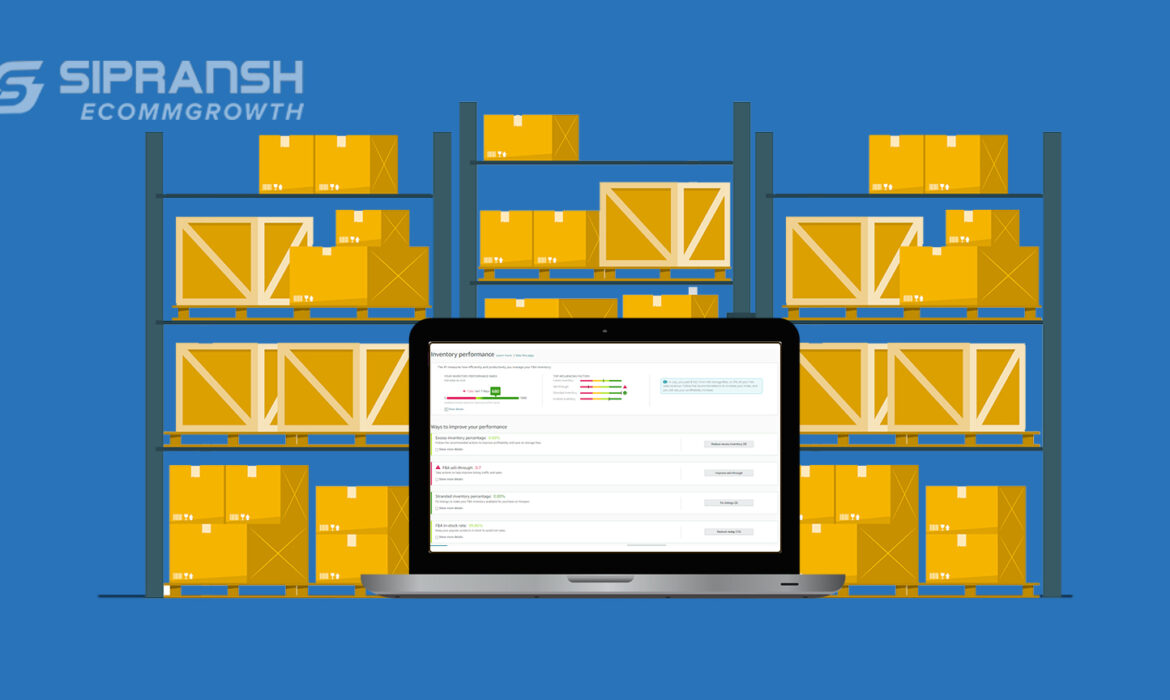
On March 1, 2023, a new FBA capacity management mechanism entered into force. Your FBA storage capacity will be determined in part by IPI going forward. For you to be a successful Amazon seller, you must have an efficient inventory management system. After all, you will lose sales and the sales rank traction you have worked so hard to achieve if you run out of stock for your best-selling products. On the other hand, having too much inventory might result in lost opportunities, storage fees, and removal charges. Your Amazon Inventory Performance Index (IPI) score is important if you use Amazon FBA for any or all of your order fulfillment. Your FBA inventory’s performance directly affects the metrics used to compute your IPI.
Since the metric was launched for FBA sellers in Q2 2018, the IPI threshold has changed a few times. The Amazon IPI threshold is 400 in 2023. It’s crucial to maintain your IPI score over the threshold all year long because you won’t receive much notice when the IPI threshold changes. Continue reading to find out how to calculate your IPI score and what you can do to raise your FBA metrics.
What Is Inventory Performance Index Score (IPI)?
The IPI score, according to Amazon, gauges how effectively and productively you manage your FBA inventory. The higher the number—which runs from 0 to 1,000—the better. Here is how Amazon shows your IPI in the Seller Central inventory dashboard.
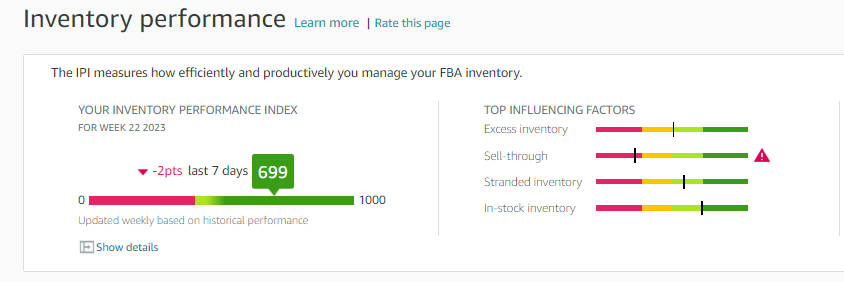
All sellers must reach a predetermined minimum threshold score set by Amazon. If your inventory health drops below that level, Amazon will impose storage restrictions on your account until you can raise it. The Inventory Performance Index (IPI) cutoff is 400 at the time of writing; anything higher than 400 is regarded as a “good” IPI score. (Be sure to pay attention to the IPI threshold as Amazon frequently modifies it). Every three months, at the end of each quarter and six weeks before it, Amazon calculates your IPI to let you know that there is still time to raise your score before they impose inventory constraints. You will be eligible for limitless storage space for each storage category (standard-size, oversize, clothes, footwear, flammable, and aerosol) if your score rises above the cutoff during these two score check weeks.
Your FBA storage capabilities and eligibility to use specific Amazon programs may be impacted by your IPI score, which is mostly determined by the following major variables:
- Keeping sales and the available inventory in balance while avoiding having too much stock
- Avoiding paying for long-term storage
- Problem-solving for your listings
- To satisfy consumer demand, keep in stock popular products.
In essence, Amazon employs the IPI score to make sure that their warehouse capacity is used effectively; specifically, that the goods sellers are storing in FBA warehouses are products that customers want and that won’t remain unsold for extended periods.
What Factors Influence Your Inventory Performance Index (IPI) Score?
Even though Amazon doesn’t provide the actual IPI score algorithm, it does explain the elements that affect your IPI score and what you can do to change them. Your IPI score is currently influenced by four factors.
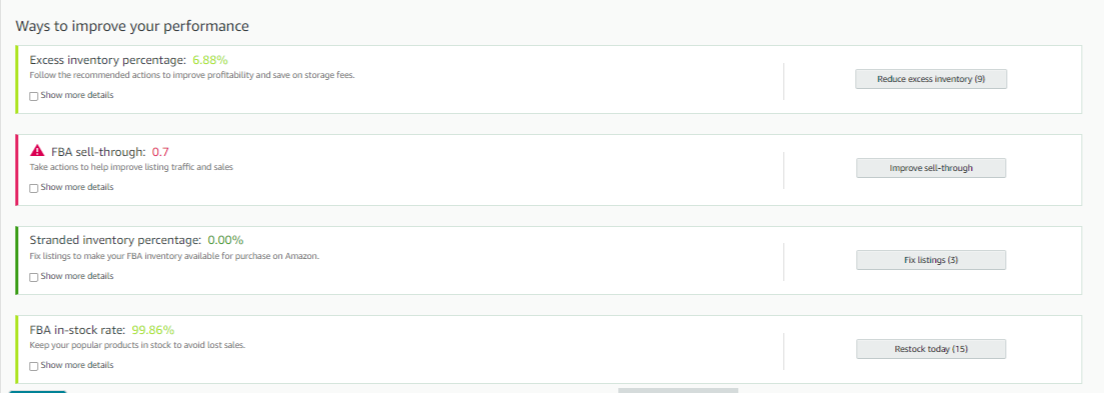
1. Excess Inventory
I think your excess inventory has the most impact on your IPI score. Remember that Amazon desires that FBA products get from the warehouse floor to consumers’ doorsteps reasonably fast and wants to act as a fulfillment center rather than a long-term storage facility.
Based on its anticipated demand, Amazon considers a product to be “excess” or “overstock” if its FBA inventory exceeds a 90-day supply. A decent rule of thumb to follow is to keep enough stock on hand to last 30–60 days. In the Inventory Dashboard, Amazon provides sellers with a useful indication of product demand and suggestions for restocking. Amazon will display the number of overstocked units if you have extra stock and offer advice on how to handle it.

Note:
- “A product is deemed to have excess inventory by Amazon if it: Has more than 90 days’ worth of supplies. One or more units were older than 90 days. An opportunity with a higher ROI, like lowering the price to boost sales.
- The estimated total storage cost is the total of the estimated expenses you would pay over three years if you did nothing and left your inventory sitting in the fulfillment center. This covers both short-term and long-term storage costs.
- How many SKUs have surplus inventory is indicated by the Reduce excess inventory To access the Manage Excess Inventory page and manage the inventory, click the button.”
2. Sell-Through Rate for FBA
Your sell-through rate is determined by dividing the number of units you shipped and sold during the previous 90 days by the typical number of units kept on hand at an FBA warehouse during that time. If Amazon thinks your sell-through rate has to be improved, they’ll let you know what steps to take. By doing this, you’ll be able to manage your storage costs and avoid being charged for long-term storage.

Choosing “Improve sell-through” will take you to the “FBA Inventory Age” page.
Each product with a low sell-through rate will be listed on Amazon along with its rank in sales over the last 60 days, sell-through rate, amount of available inventory, inventory age, and an estimate of the cost of long-term storage.

You can see their advice for raising the sell-through rate to the right. In the below screenshot, the drop-down states that Amazon is urging me to reduce the “Cost of my offering”, “Improve keywords” and “Advertise listing, etc.”
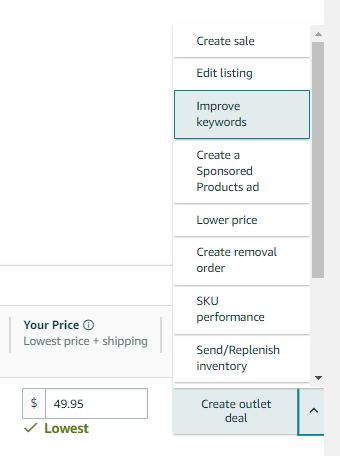
3. Stranded Inventory
When you have stock in Amazon’s warehouse but there isn’t any active demand for the item because of a listing issue, you have stranded inventory. Customers won’t be able to buy that inventory as a result, which will result in missed revenue and storage costs. Amazon will tell you exactly how many units are stranded and how to fix them, so fortunately, this is a relatively simple problem to address. Your inventory performance dashboard will display an alert and a “Fix listings” button if you have stranded inventory.

By selecting “Fix listings,” you will be taken to the “Fix stranded inventory” page. The products that are stranded will be listed by Amazon together with information on how many units are stranded, whether they have an auto-removal date, the cause of their stranding, and the ability to relist the products.
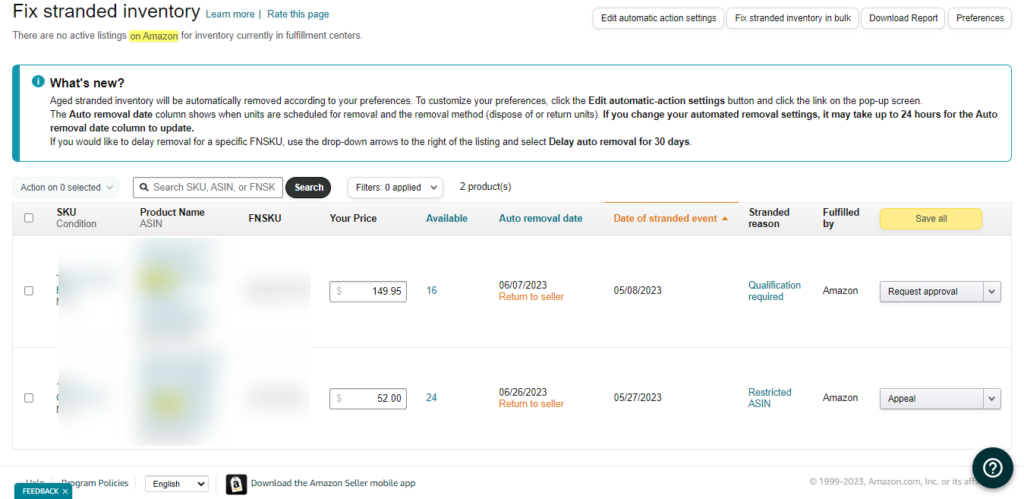
4. In-Stock Inventory
Depending on how successfully you manage to keep it in stock popular ASINs, Amazon monitors your performance. Although it won’t hurt your IPI score, this metric can raise it.
Amazon will estimate the number of FBA sales you missed over the last 30 days based on expected sales on the days you were out of stock to emphasize the need to maintain a healthy inventory. You can subtract a non-replenishable product from your IPI score if it is the one you are selling. Therefore, you can label a product as “non-replenishable” under
Restock inventory if it is a one-off retail arbitrage item, a limited edition product, or a product that is no longer being produced to safeguard your IPI score.

How Is Amazon’s IPI Calculated?
In Seller Central’s Inventory Dashboard, you may see your current score. To see your IPI Score, confirm that your Seller Central account is active.
Your IPI has a separate dashboard. To see it:
1. Login with Seller Central
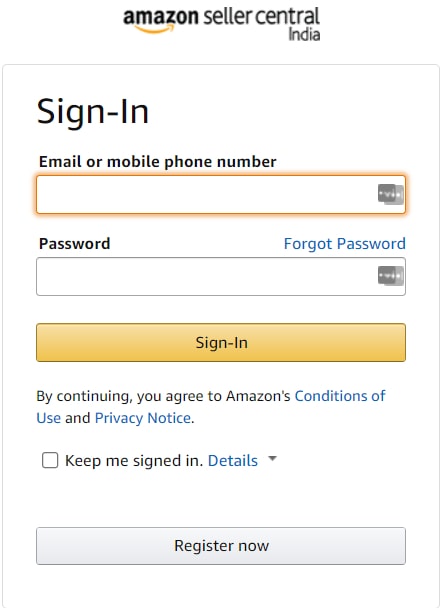
2. The drop-down option will appear when you click on Inventory; choose Inventory Planning.
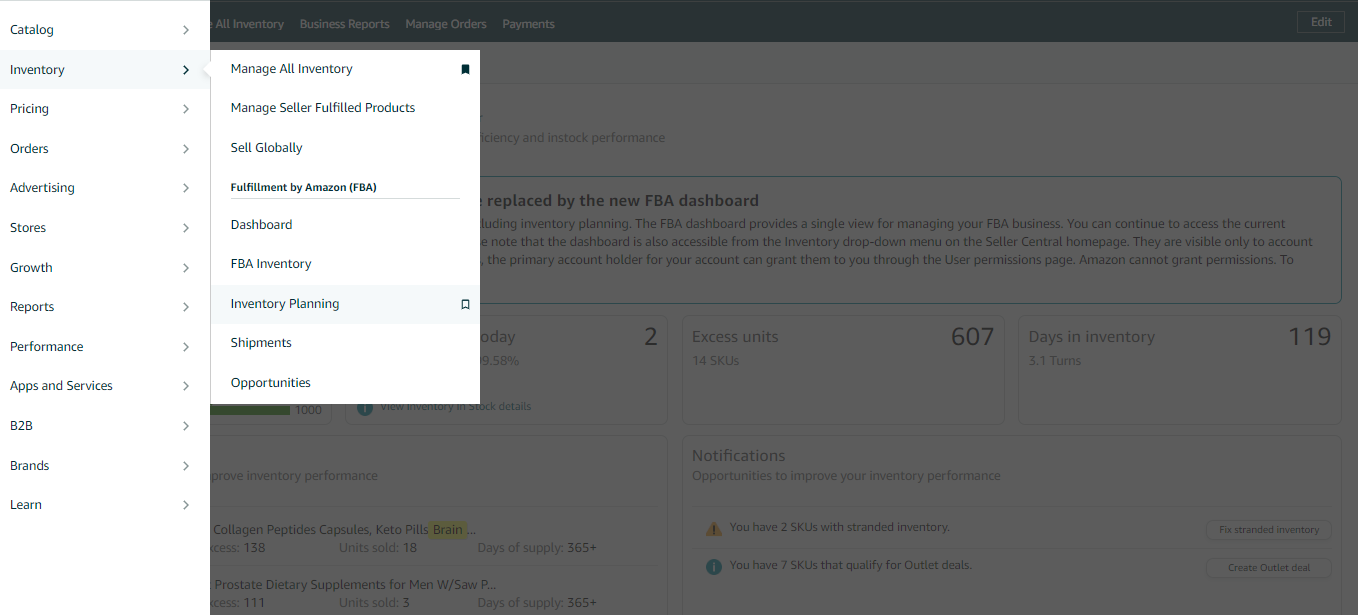
3. To view your IPI score, click the Performance tab.

Go to the bottom of the page and select the EXPAND STORAGE MONITOR tab.
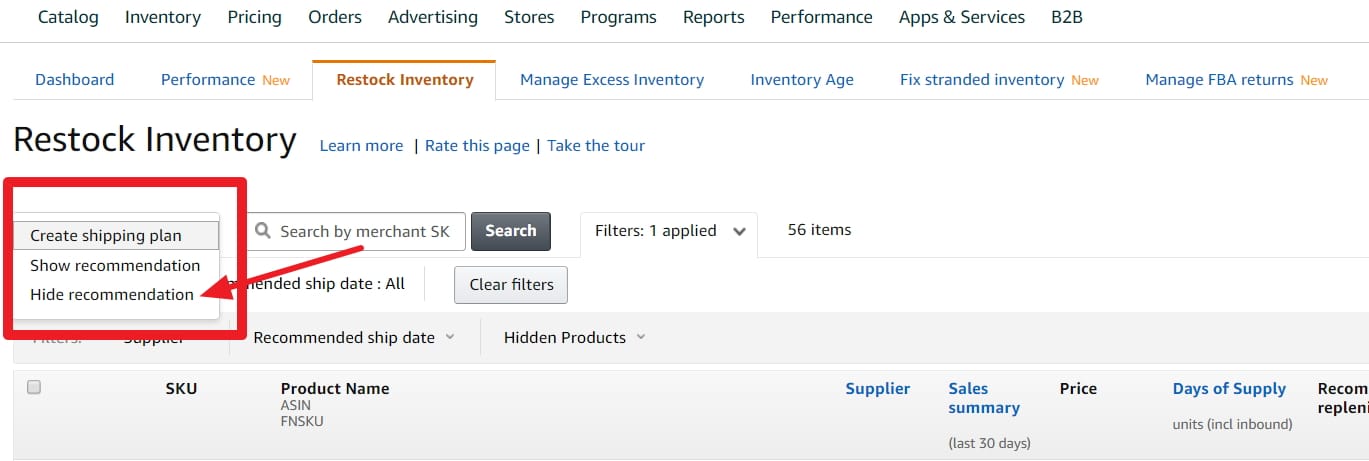
With the use of these three actions on the Inventory Performance Dashboard, Amazon enables sellers to raise their IPI score:
- Recommendations for excess inventory to reduce holding, storage, and carrying costs.
- Restock recommendations to boost the in-stock percentage.
- To guarantee the availability of product listings, provide actionable insights on stranded inventory items.
Every Monday, your IPI score is revised based on your most recent 3-month performance statistics.
Common Misconceptions About Inventory Performance Index (IPI) Scores
Let’s talk about some false beliefs concerning IPI scores as well:
- False: IPI Scores have an impact on ASIN Limits. Your IPI ratings have no bearing on the ASIN replenishment limits that Amazon imposes during certain times.
- This claim that new products lower your IPI rating is untrue. Launching new products does not lower your IPI score because Amazon only considers a product’s sales history after 90 days.
- It’s untrue to say that new Seller accounts have an IPI score. It will take new seller accounts about 15 weeks after sending their first item to Amazon FBA fulfillment centers before they receive an IPI score.
- This claim that you may significantly raise your IPI score rapidly is untrue. Both recent sales/storage activity and past sales/storage activity are included in your IPI.
- It is untrue that marking products as non-replenishable improves your IPI score. Your IPI score is unaffected by marking an item as non-replenishable.
How To Maintain Your Inventory Performance Index?
A few common suggestions are provided by Amazon for preserving a healthy inventory performance.
1. Your Sell-Through Rate Should Be Increased.
A good 90-day rolling sell-through rate that puts you in the “green” on the IPI graph is what Amazon wants from its merchants. Visit the “Inventory Age” page in your inventory dashboard to see the sell-through rate for each of your active products. The products with the lowest sell-through can be sorted, and you can see suggestions for raising them.
By running a promotion to boost conversions, marketing your goods, honing your keyword targeting technique, and employing more potent listing photos, you can raise your sell-through rate.
2. Cut Back On Excessive Stock
This one should go without saying: Amazon does not want to hold unsold goods. For advice on how to handle surplus inventory, go to the “Manage excess inventory” page in your inventory dashboard. Amazon might also advise you to put up an “Amazon Outlet” offer to sell out-of-season goods and overstock merchandise rapidly.
If you have too much inventory in your Amazon fulfillment centers, you need to sell it or get rid of it. Based on what Amazon believes you’ll need to refill over the next 90 days, excess inventory is computed. Anything above that is regarded as excess stock. To sell this stock, you might consider lowering the price, liquidating, increasing your advertising efforts, or combining the first three strategies. To avoid accruing storage fees, you can also create a removal or disposal request.
3. Avoid paying for long-term storage.
Make careful to get rid of any goods before FBA’s 365-day limit is reached. You will be charged high long-term storage fees if your inventory is more than 365 days old. You can order your merchandise to be removed or even have Amazon destroy it.
4. Take charge of listing issues
Take prompt action to resolve any listing issues, such as stranded goods, that are stopping buyers from making a purchase. In general, you ought to:
- Check your percentage of stranded goods frequently so you can address the problem before you start incurring higher storage costs.
- Keep your sold and available inventory levels in balance.
- A 90-day stockpile of goods or more, based on your sales projection, should be avoided.
- Maintain adequate stock levels of your most popular products (between 30 and 60 days’ worth of supplies).
- you make sure you’re on the correct track, and be sure you constantly check your inventory dashboard.
5. Fix Stranded Inventory
Several factors can cause inventory to become stranded. Perhaps the listing was incorrect, or perhaps you deleted a listing but left the inventory at FBA. Each stranded ASIN’s problem will be disclosed to you by Amazon in Seller Central. Regularly check for stranded goods, and take care of any problems right away. You’ll have an excellent IPI score if you can maintain inventory and sell your goods. For your Amazon business to continue to run smoothly and to retain a high IPI score, accurate and timely inventory forecasting is essential.
6. Maintain Stock
Your FBA in-stock rate is calculated by Amazon based on the number of days you spent in stock there during the previous 30 days. This only holds for replenishable goods. Mark the item as non-replenishable in Seller Central if you don’t intend to replenish it.
What Happens If Your Inventory Performance Index (IPS) Score Falls Below the Cutoff?
Inventory storage restrictions will apply if your Amazon IPI score falls below the 450-point cutoff. You can access your store and the new restock limitations by going to “Inventory performance” or “Manage FBA shipments.”
Amazon restricts your ability to stock more inventory and charges you $10/cu ft for any extra units you have in stock if your Inventory Performance Index is below 350 six weeks before or during the conclusion of the quarter.
It is vital for you to regularly evaluate your inventory performance index (IPI) because the penalties are typically significant, could result in expensive storage fees, and could result in lost Amazon sales.
What A Seller Should You Do?
We can only make educated guesses as to some concrete actions you can take to avoid being penalized by a low IPI because the algorithm used to determine it is unknown:
- Check your IPI rating right now.
- Make sure your IPI is higher than the required level (between 400 and 500), either after the quarter or six weeks beforehand.
- Increase the frequency of delivering inbound shipments to Amazon and better utilize 3PLs for storage
- Maintain a supply level of no more than 30 to 60 days.
- Remove surplus inventory and immediately fix stranded inventory
- If you believe you will fall below 400 for both reporting periods, prepare shipments in advance.
To this latter point, making shipments beforehand is one current method of getting around the IPI. Your ability to create inbound shipments will be impacted if your account has restrictions. You may, however, send in that inventory as long as those shipments have already been made.
Let SIPRANSH ECOMMGROWTH Improve Your IPI Score
If you don’t have the expertise or enough time then consider expert guidance from a reputed firm that provides Amazon SEO or Amazon consulting services. We, Amazon seller experts assist Amazon sellers in improving their IPI (Inventory Performance Index) score by implementing various strategies and best practices. Here are some ways:
1. Inventory Management: Effective inventory management is crucial for maintaining a good IPI score. We analyze your inventory data, identify slow-moving or excess inventory, and recommend strategies to optimize your stock levels. This might include setting up automated reorder systems, forecasting demand, and implementing just-in-time inventory practices.
2. Sales & Promotion Strategy: Our team of experts can help you develop a sales and promotion strategy to increase your product sales and reduce the likelihood of excess inventory. This can involve optimizing your product listings, implementing effective pricing strategies, and running targeted marketing campaigns to drive traffic and sales.
3. Demand Planning: By analyzing historical sales data and market trends, we improve your demand planning. This will allow you to align your inventory levels with anticipated demand, reducing the risk of stockouts or overstock situations.
4. Supplier Management: A reliable supply chain is essential for maintaining optimal inventory levels. Our team assists in evaluating and managing your supplier relationships, ensuring timely deliveries and efficient order fulfillment.
5. Product Bundling & Cross-Promotion: Our team of experts suggests opportunities for product bundling or cross-promotion, helping you increase sales and move inventory more effectively. By strategically combining related products or offering discounts on complementary items, you can improve sales velocity and reduce the likelihood of excess inventory.
6. FBA (Fulfillment by Amazon) Optimization: If you are using FBA, we optimize your fulfillment processes. Also analyze your inbound shipping, storage, and removal fees, and provide recommendations on how to reduce costs while improving inventory turnover.
7. Listing Optimization: Optimizing your product listings is crucial for improving your visibility and conversion rates. Our team assists in keyword research, optimizing titles, bullet points, descriptions, and images to enhance your listing’s quality and relevance, ultimately driving more sales and improving your IPI score.
8. Analytics & Reporting: We provide you with comprehensive analytics and reporting tools to track your inventory performance and identify areas for improvement. By monitoring key metrics such as sell-through rates, days of inventory, and order defect rates, you can proactively address any issues that may impact your IPI score.






